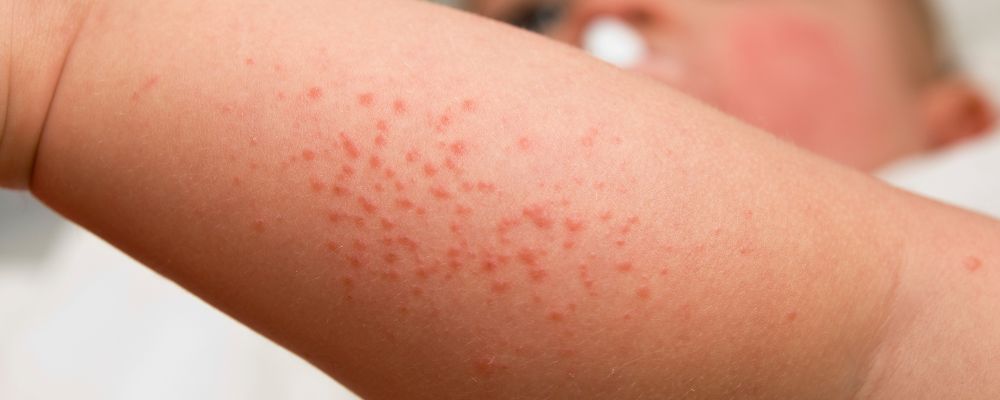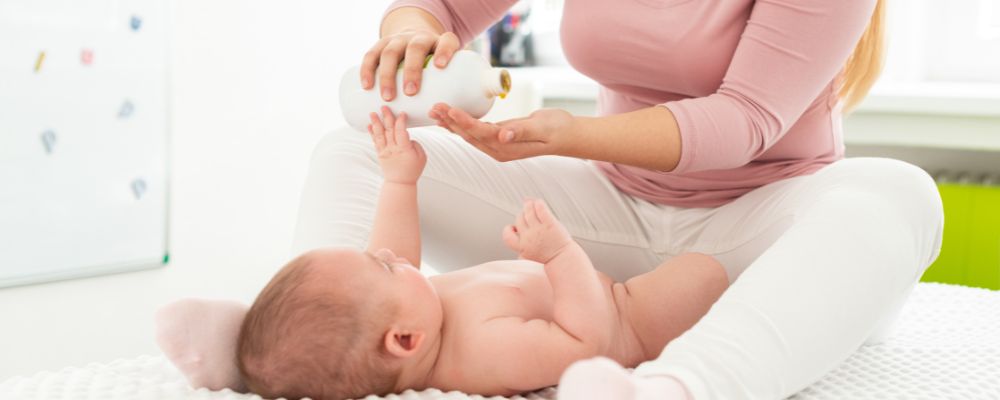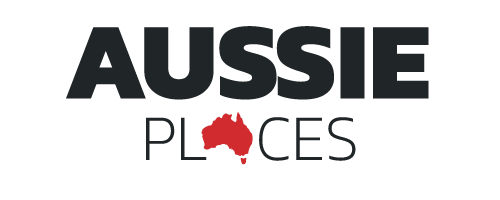Baby skin is incredibly delicate, and it’s not uncommon for infants to develop rashes for various reasons. As parents, it’s our utmost priority to ensure the well-being and comfort of our little ones, and this includes taking care of their skin. While it’s reassuring to know that many baby rashes are a natural part of infancy, it’s essential to use safe and gentle remedies to alleviate any discomfort your baby may be experiencing. In this guide, we will explore how to effectively treat baby rashes at home, providing you with valuable information and techniques to help keep your newborn’s skin healthy and radiant.
Understanding Baby Rash

The term “baby rash” refers to a broad category of skin irritations that commonly affect newborns and early children. When it comes to parenting, it’s important to take a moment to think things through before applying any treatment. Knowing exactly what kind of rash you’re dealing with is key to providing the right care for your baby’s skin. To give your kid the best care possible, you must find out the complex nature of these rashes and their underlying causes.
There are many different ways that baby rashes can appear, and each has its own special traits. They could show up as red spots, elevated pimples, dry skin patches, or episodes of continuous itching. These rashes can occur in a variety of places; common locations include the neck area, the delicate skin of the face, and the diaper area. Numerous things, such as environmental irritants, allergies, heat, or even underlying medical issues, can cause these rashes. You’ll be in a better position to give your child the right care and keep their skin pleasant if you have a complete awareness of the various kinds and possible causes of these rashes.
Home Remedies For Treating Baby Rash

1. Coconut Oil
Coconut oil’s calming and hydrating qualities make it an effective natural treatment for baby rashes. This mild oil helps the skin maintain moisture and minimise inflammation, in addition to providing nourishment and forming a protective barrier. Your baby’s sensitive skin will receive much-needed relief when you apply a small layer of coconut oil to the affected region. The oil acts as a soothing shield against dryness, redness, and itching.
Pro Tip:
Check out the best body lotion for infants that offers gentle care and moisturization for your baby's sensitive skin.
2. Oatmeal Blend
Oatmeal is well known for its amazing capacity to reduce inflammation and itching. Making an oatmeal blend is an easy task. Oatmeal can be ground into a fine powder and combined with water to make a soothing paste. This mixture acts as a soothing agent, relieving pain and soothing inflamed skin when applied topically to the rash. Your baby’s skin will feel soothed and renewed once you gently rinse it off with lukewarm water after letting it work its magic for a short while.
3. Chamomile Tea Compress
Chamomile tea, recognised for its anti-inflammatory and soothing effects, is a well-known ally. A cup of chamomile tea, brewed and allowed to cool, lays the foundation for an outstanding calming solution. Chamomile’s gentle yet effective qualities can be accessed by soaking a clean cloth or a cotton ball in the cooled tea and gently dabbing the affected region. This not only decreases redness and irritation but also provides a safe and dependable option for dealing with newborn rashes, leaving your baby’s skin feeling relaxed and relieved.
4. Aloe Vera Gel
Aloe vera gel is a superb natural medicine known for its soothing and healing properties. Because of its anti-inflammatory characteristics, aloe vera gel is ideal for treating common skin disorders in newborns. When applied to the rash, it provides a cooling feeling that aids in the reduction of redness and the healing of the damaged skin. This soft and safe solution provides pleasant relief for soothing sensitive skin, making it a reliable choice for newborn rash control.
5. Breast Milk
Breast milk is an excellent natural therapy for a range of newborn skin problems. It is a simple yet highly effective remedy since it contains natural moisturisers and necessary antibodies. You can harness the soothing and moisturising powers of breast milk by applying a few drops to the affected region and allowing it to air dry. Breast milk is especially beneficial since it protects the baby’s delicate skin and speeds up the healing of rashes, making it a convenient and safe option for parents.
6. Calendula Salve
The plant calendula is well-known for its restorative and anti-inflammatory qualities. By calming and encouraging healing, calendula salve can provide your baby’s skin with much-needed respite. For treating a variety of skin issues, this natural salve is especially secure and efficient. It’s a reliable companion in your baby’s skincare routine as it offers a gentle yet effective method to alleviate irritation, redness, and discomfort caused by rashes.
Pro Tip:
Find the perfectbaby wipes for your little one's comfort and cleanliness, ensuring a convenient and gentle solution for all your diaper-changing needs.
7. Neem
The adaptable natural treatment of neem is well-known for its antibacterial qualities. It has long been used traditionally to treat a variety of skin conditions. When diluted appropriately, neem oil can be administered topically to a rash to promote healing and reduce inflammation. Because of its inherent antibacterial properties, neem is a safe and mild option for treating newborns’ skin irritations and improving skin health.
8. Banana Peels
Banana peels may be an unexpected yet powerful treatment. They are high in antioxidants and have natural calming characteristics that can be gently massaged onto the rash to bring relief. The natural properties of the peel aid in calming irritated skin, making it an easy and accessible choice for parents looking to relieve the discomfort associated with rashes.
9. Cucumber
Cucumber is well-known for its cooling and moisturising effects. Cucumber slices or puree can be placed on the rash to provide relief and refreshment. Cucumbers can reduce inflammation and redness, making them an important part of your baby’s skincare routine. Their natural cooling effects soothe your baby’s delicate skin.
10. Essential Oils
To address specific skin concerns in newborns, some essential oils, such as lavender or chamomile, can be properly diluted and used in moderation. When it comes to essential oils and a baby’s skin, however, caution is advised. It is critical to seek advice from a healthcare practitioner. The use of essential oils should be undertaken with caution to ensure your baby’s safety and well-being. When applied correctly, these oils can be excellent for effectively and naturally managing skin concerns.
Common Skin Rashes in Newborns and Infants

Here is a list of some of the most common baby rashes, along with details to assist you in determining the cause and potential home remedy.
1. Dry, Flaky, Or Peeling Skin
Dry, flaky, or peeling skin is a common occurrence in newborns and infants, and it shares similarities with the dry skin concerns that adults may encounter. This type of rash typically presents as patches of skin that appear rough, scaly, or excessively dry to the touch. It can affect various parts of the baby’s body, including the arms, legs, and even the face.
While dry and flaky skin in infants is usually a harmless condition, it’s important to address it promptly. If left unattended, this rash can progress, potentially leading to skin irritation and even swelling. This discomfort can make your baby cranky and restless. To ensure your little one’s skin remains comfortable and smooth, it’s crucial to follow gentle and nourishing skincare routines, such as using baby-friendly moisturisers and ensuring proper hydration, especially in dry or cold weather. Keeping your baby’s skin soft and supple is an integral part of their overall well-being.
2. Baby Acne
Baby acne is a common skin condition that newborns often experience. It is characterised by tiny, pimple-like bumps that appear on their delicate skin. Unlike adult acne, it rarely progresses to the stage of developing blackheads or whiteheads. Baby acne can have different presentations. It may manifest as a few small bumps spread out over a larger area, or it can be more concentrated, with numerous tiny bumps closely clustered together.
Pro Tip:
Craft a nurturing newborn skin care routine to keep your baby's delicate skin soft, smooth, and healthy from the very beginning.
Although baby acne can be a cause for concern for parents, it is usually harmless and temporary. It often occurs in the first few weeks of a baby’s life and can last for a few months. While the exact cause of baby acne is not clear, it is often attributed to hormonal fluctuations or reactions to specific skincare products. The good news is that baby acne typically goes away on its own without any need for intervention. However, it is important not to squeeze or attempt to pop the bumps, as this can lead to skin irritation.
3. Cradle Cap
Cradle cap is a relatively common rash that manifests as crusty or oily scaly patches on a baby’s scalp. Unlike other rashes, this condition is typically not painful or itchy for the infant. However, because it causes thick, white, or yellowish scales to grow and stick stubbornly to the baby’s scalp, it can be unsettling for parents. Caretakers may be concerned about these scales since they can be difficult to remove.
If the cradle cap is left untreated, it has the potential to extend its reach beyond the scalp, rapidly affecting other areas of the baby’s body. It may begin to appear on your baby’s ears, neck, or even the facial region. This expansion can be distressing, as it becomes more noticeable and widespread. Although the cradle cap can persist for several weeks or even months, rest assured that it is usually a harmless and transient condition that eventually resolves itself. It’s crucial to maintain patience and regular care to ensure your baby’s comfort and the gradual disappearance of these unsightly scales.
4. Milia
Milia is a common skin condition you might notice in a newborn or infant. It’s when you see tiny, pearly-white, or yellowish bumps on your nose, cheeks, or chin. These little bumps usually don’t cause any discomfort, such as pain or itching.
Milia happens when tiny bits of skin get trapped and block the sweat ducts or hair follicles on your baby’s skin. Over time, as your baby’s skin matures, these bumps tend to disappear on their own without needing any special treatment. It’s important not to try to pop or pick at them because this can lead to skin irritation. While milia might seem concerning at first, it’s typically a temporary issue that will go away on its own with a little patience as your baby’s skin grows and matures.
5. Prickly Heat
Prickly heat, also known as heat rash, is a common skin issue that can affect babies, particularly during hot and humid weather. It occurs when sweat ducts become clogged, trapping sweat underneath the skin’s surface. This trapped sweat can give rise to small, red bumps that may cause discomfort for your little one. Prickly heat often appears as a cluster of red bumps on the skin, which can sometimes be mistaken for other conditions, such as baby acne. It frequently occurs in areas of the body that are prone to sweating, such as the armpits, neck, and diaper area. These regions are ideal breeding grounds for prickly heat, as sweat tends to accumulate due to the lack of proper ventilation.
To prevent and manage this rash, it’s crucial to maintain an environment that keeps your baby cool and comfortable, especially in hot and humid conditions. Key strategies to address and prevent prickly heat include proper ventilation, dressing your baby in breathable fabrics, and avoiding overheating. These measures will help ensure your baby’s skin stays happy and rash-free.
6. Diaper Rash
Diaper rash is a common concern among parents, characterised by redness, irritation, and potential peeling or blistering in the diaper area. It’s often more likely to occur when disposable diapers are used because they can trap moisture against the baby’s skin. The combination of prolonged exposure to wetness and friction from the diaper and the skin’s sensitivity to the materials in disposable diapers can contribute to this rash.
To prevent and alleviate diaper rash, several key steps are essential. Regular diaper changes help keep the baby’s skin dry and minimise friction, reducing the risk of irritation. Gentle cleaning with mild, fragrance-free baby wipes is crucial, and choosing gentle wipes is important to avoid exacerbating the problem. Applying a protective barrier cream acts as a shield against moisture and irritants, further reducing the risk of diaper rash. By understanding the causes and implementing these preventative measures, parents can significantly reduce the occurrence and severity of diaper rash, ensuring their baby’s skin remains comfortable and healthy.
7. Eczema
Eczema, also known as atopic dermatitis, is a chronic skin condition that can affect babies. It shows up as red, itchy, and sometimes scaly patches of skin, which can be quite uncomfortable for your little one. Eczema happens because your baby’s skin has a thin protective layer, making it dry and sensitive and more likely to react to things like dust or rough clothing
Pro Tip:
Discover common triggers and factors that cause allergies in newborns, helping parents ensure a healthy and allergy-free start for their little ones.
To tackle eczema, you’ll want to do a few things. First, keep your baby’s skin moisturised regularly. This helps because dry skin can make eczema worse. Also, use gentle, fragrance-free soaps to keep your baby’s skin clean. Avoiding things that might trigger eczema, like harsh detergents or foods that could cause allergies, is important too. Depending on your baby’s age, eczema can appear in different places, such as the chest, arms, legs, elbows, knees, or even on the face. So, keep an eye out for itchy patches and take steps to help your baby feel better.
8. Allergens
For some babies, their skin is incredibly sensitive, and exposure to allergens can lead to the development of rashes. These allergens can come from various sources, including what they eat or come into contact with, such as detergents, fabrics, fragrances, and more. These rashes can take on different appearances, making them somewhat challenging to identify at times.
These reactions may require close observation and the identification of the specific allergen responsible for the rash. It’s important for parents to have a correct understanding of what their baby might be reacting to, as this can vary from one infant to another. The key is to minimise exposure to potential allergens and, when necessary, seek guidance from a healthcare professional to determine the cause and best steps for managing these reactions.
Tips To Prevent Rashes In Babies
- Choose Gentle Detergent: Opt for a baby detergent that is gentle and low on harsh chemicals when washing your baby’s clothes. Harsh products can potentially irritate their delicate skin.
- Breathable Fabrics: Dress your baby in clothing made from breathable fabrics, like cotton. This helps prevent their skin from becoming overheated and reduces the risk of rashes.
- Food Allergens: If you’re breastfeeding, be mindful of your diet and how it may affect your baby. Some babies can be sensitive to certain foods through breast milk, so pay attention to potential allergens.
- Baby-Friendly Skincare: Choose skincare products specially formulated for babies. Look for hypoallergenic options to minimise the risk of skin irritations.
- Frequent Diaper Changes: Ensure you change your baby’s diapers regularly. Extended exposure to moisture, urine, and faeces can lead to diaper rashes. Keeping them dry is essential.
- Thorough Drying: After bath time, make sure to pat your baby’s skin completely dry before applying any moisturiser or cream. Even slight dampness can increase the chances of rashes.
- Prickly Heat Prevention: To avoid prickly heat rashes on their face and body, dress your baby in loose-fitting clothes that allow their skin to breathe. This helps regulate their body temperature and reduces the risk of heat-related rashes.
Conclusion
In your role as a parent, looking out for your baby’s well-being is a top priority. This involves not only learning how to treat baby rashes at home using safe and effective remedies and selecting gentle products for their sensitive skin but also making sure they get the right nutrition and exercise. A balanced diet and age-appropriate physical activities are essential for their growth, development, and overall happiness. By taking care of their health, skin, and lifestyle, you’re ensuring they have a loving and secure environment in which to flourish. Your baby’s well-being is your responsibility, and it’s a journey filled with love, care, and the joy of watching them grow.

